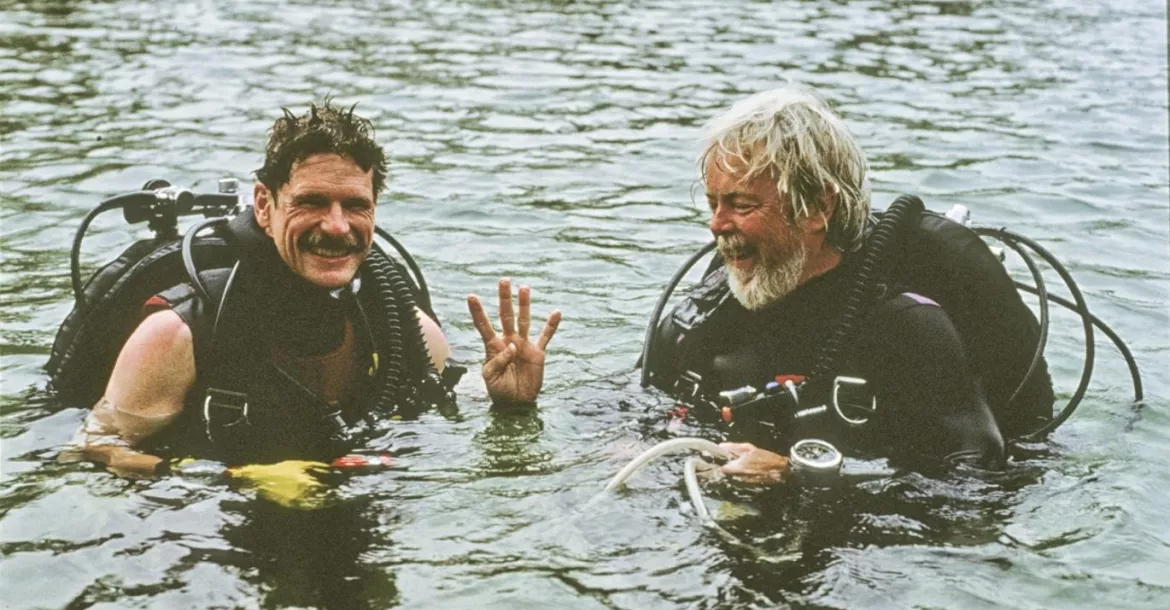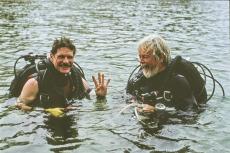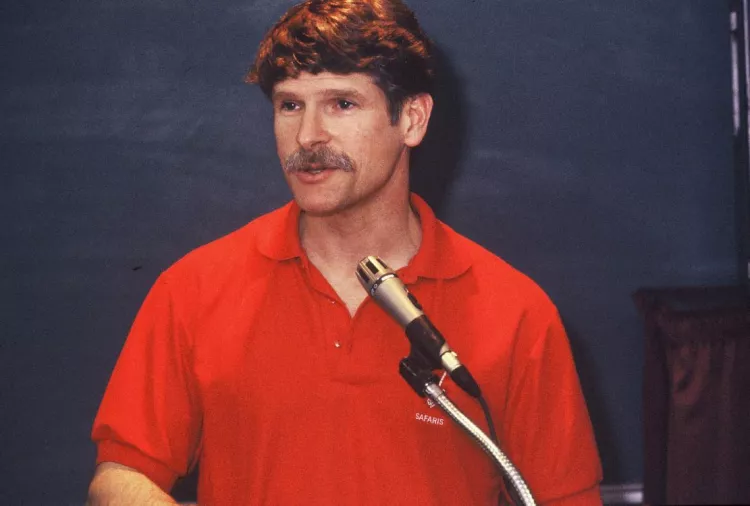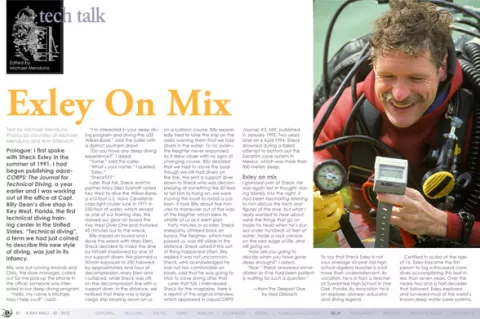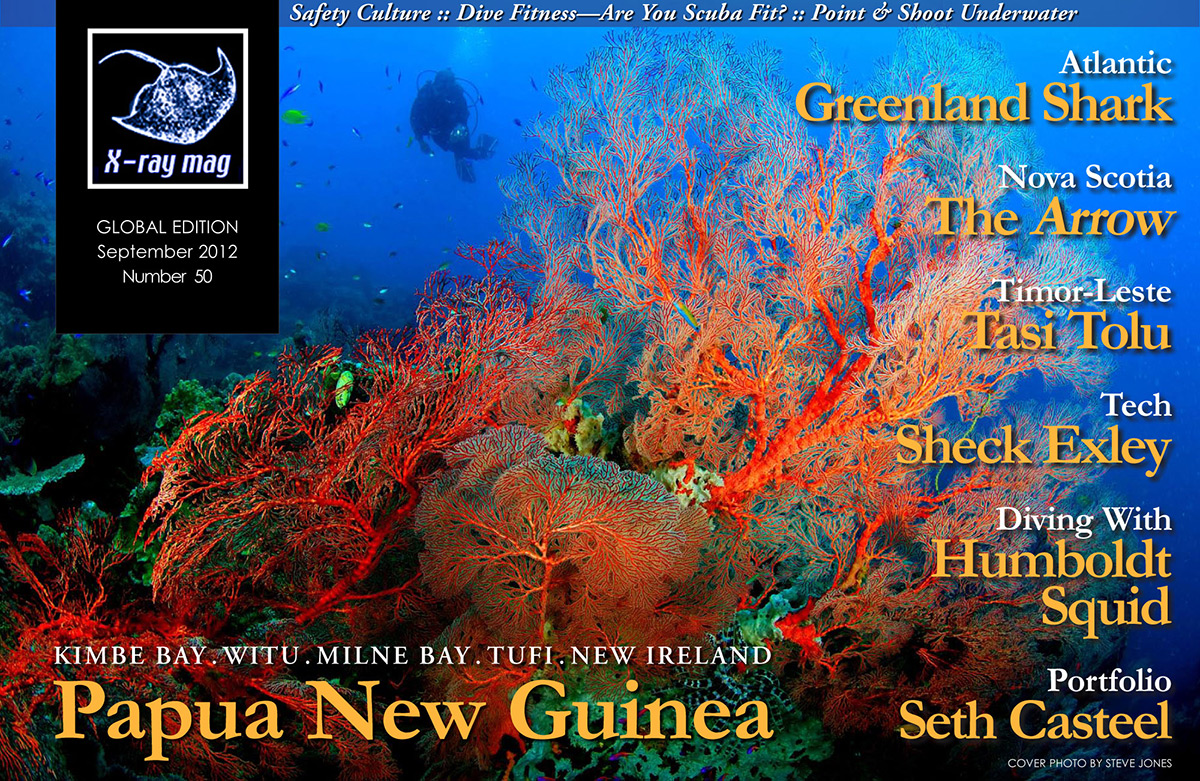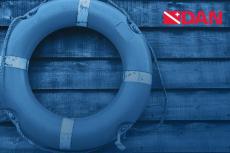I first spoke with Sheck Exley in the summer of 1991. I had begun publishing aquaCORPS: The Journal for Technical Diving, a year earlier and I was working out of the office at Capt. Billy Dean’s dive shop in Key West, Florida, the first technical diving training center in the United States. “Technical diving”, a term we had just coined to describe this new style of diving, was just in its infancy.
Contributed by
Billy was out running errands and Chris, the store manager, called out for me pick-up the phone in the office: someone was interested in our deep diving program.
“Hello, my name is Michael. May I help you?” I said.
“I’m interested in your deep diving program and diving the USS Wilkes-Barre,” said the caller with a distinct southern drawl.
“Do you have any deep diving experience?” I asked.
“Some,” said the caller.
“What’s your name,” I queried.
“Exley.”
“Sheck???”
Later that fall, Sheck and his partner Mary Ellen Eckhoff visited Key West to dive the Wilkes-Barre, a 610-foot U.S. Navy Cleveland-class light cruiser sunk in 1971 in 250-foot of water, which served as one of our training sites. We stowed our gear on board the Key West Diver One and motored 45 minutes out to the wreck.
Billy stayed on board and I dove the wreck with Mary Ellen. Sheck decided to make the dive by himself shadowed by one of our support divers. We planned a 20-min exposure to 250 followed by approximately and hour of decompression. Mary Ellen and I surfaced, while Sheck was still on the decompression line with a support diver. In the distance, we noticed that there was a large cargo ship bearing down on us on a collision course. Billy repeatedly tried to raise the ship on the radio warning them that we had divers in the water.
To no avail—the freighter never responded. As it drew closer with no signs of changing course, Billy decided that we had to move the boat though we still had divers on the line. We sent a support diver down to Sheck who was decompressing at something like 60-feet, to tell him to hang on, we were moving the boat to avoid a collision. It took Billy about five minutes to maneuver out of the way of the freighter which blew its whistle at us as it went past.
Forty minutes or so later, Sheck sheepishly climbed back on board. The freighter, which had passed us, was still visible in the distance. Sheck asked if this sort of thing happened often. Billy replied it was not uncommon. Sheck, who acknowledged he was not too comfortable on boats, said that he was going to stick to cave diving after that.
Later that fall, I interviewed Sheck for the magazine. Here is a reprint of the original interview, which appeared in aquaCORPS Journal, #3, MIX, published in January 1992. Two years later on 6 April 1994, Sheck drowned during a failed attempt to bottom out the Zacatón cave system in Mexico, which was more than 300 meters deep.
Exley on mix
I glanced over at Sheck. He was again lost in thought, staring blankly into the night. It had been fascinating listening to him discuss the facts and figures of the dive, but what I really wanted to hear about were the things that go on inside his head when he’s buried under hundreds of feet of water, inside a rock crevice, on the very edge of life, and still going on.
“How are you going to decide when you have gone deep enough?” I asked.
“Fear,” Sheck answered immediately as if he had been patiently waiting for such a question.”
—from The Deepest Dive
by Ned Deloach
To say that Sheck Exley is not your average 42-year-old high school algebra teacher is a bit more than understatement. By vocation, he is in fact a teacher at Suwannee High School in Live Oak, Florida. By avocation he is an explorer, pioneer, educator and diving legend.
Certified in scuba at the age of 16, Exley became the first person to log a thousand cave dives accomplishing this feat in less than seven years. Over the nearly two and a half decades that followed, Exley explored and surveyed most of the world’s known deep water cave systems, pioneered many of the methods and techniques of deep air and special mix scuba, and in doing so, has repeatedly redefined the limits of self-contained diving.
His exploits and verve have earned him the reputation of being one of the finest divers in the world, and have shaped the development modern cave diving, which is regarded by many as a model for specialized dive training. A teacher and soft-spoken educator, Exley helped to establish the National Speleological Society’s Cave Diving Division (NSS-CDS) in 1973, has published over 100 articles and six books on the subject of his passion, lectures extensively, and currently offers a mixed gas training program for experienced divers.
Perhaps pioneers like Exley will always remain an enigma. An explorer and athlete of the highest magnitude, combining physical ability with the psychological stamina necessary to venture where few will ever go, to others, perhaps, he is seen as a daredevil and risk taker seeking a thrill.
Recently aquaCORPS caught up with Exley hoping to try and explain and reconcile the many stories that have grown up around the man, to understand his motivation, to get inside his head. The results were more than we had anticipated.
MM: When did you start diving Sheck?
SE: I got started in 1965 but I didn’t really start keeping a log until February 1966 when I went on my checkout dive with Ken Brock. He taught me how to dive. That first dive we went down and I stuck my head under a coral ledge, what you might call a coral cave, maybe 16 feet deep [chuckles]. Wasn’t much of anything, and I really didn’t enjoy it. But then Ken took me to Crystal River and I really got turned on. I didn’t have a light or anything so I kind of wandered off into the cavern there, my eyes adjusted and I swam a little bit further, peering off into the darkness. I guess I’ve been peering off into that darkness ever since.
MM: You’ve made some incredible dives in your career; your “Salute the Flag” dive at Diepolder II to 360 feet on air, Wakulla, El Nacimiento de Rio Mante to 870 feet, your 10,939 foot penetration at Cathedral, why do you do what you do?
SE: I’m not sure. My motivation has changed a lot over the years. I grew up diving, and as a teenager I wanted to be important and to be thought of as important. I went through a stage where I wanted to see how deep I could go. Then I went through a stage to see how far I could go. I still enjoy that.
There are places that no one else has been to since the dawn of time. We can’t see what’s there. We can see what’s on the dark side of the moon or what’s on Mars, but you can’t see what’s in the back of a cave unless you go there. There’s a special feeling when you know no one else has been there before. And it’s an extra special feeling when you know no one has ever been that far. I enjoy that feeling.
MM: Your Nacimiento Mante dive must have been like that?
SE: It was frightening. I’d use the term “physiological roulette” to describe my four Mante dives. The first to 520 feet in 1987 was probably the most frightening. It was really stepping out into no-man’s land as far as the western hemisphere was concerned. Jochen Hassenmayer of course had been deeper at Fontaine-de-Vaucluse.
MM: Was Mante your first big mix dive?
SE: I had done practice dives of course: 130 feet at Cathedral and 260 feet at Holton Springs. Dale Sweet’s 360 feet trimix dive at Diepolder back in 1981 was the only dive in the western hemisphere that was close to it. In the eastern hemisphere, there were Jochen’s dives. He had been to 660 feet, which gave me a lot of confidence.
MM: You knew it was doable?
SE: I knew it was doable. I had dived with Jochen. He’s an extremely impressive diver, as good as any I have dived with. The fact that I had actually met the man and dived with him made me feel a bit more confident. Decompression tables were a problem of course. There was nothing available. I had never heard of Bill Hamilton at the time. Fortunately I was able to get a hold of some commercial tables that Jim Melton got for me as a model.
MM: You used commercial tables?
SE:No, I had to extrapolate them; the tables stopped at 400 feet. I had to take the model and extrapolate beyond that. I did the same thing on the 660 feet dive two months later.
MM:You know a lot of people would say, “Sheck is nuts.” Why would he construct his own decompression tables; isn’t that just foolhardy and crazy?
SE: Isn’t that basically what everyone does?
MM: Ha! Good point.
SE: I may not be the world’s greatest mathematician, but mathematics is my profession and I have a degree in computers; both of them lend themselves quite well to figuring out a decompression schedule. I’m sure Bill Hamilton wouldn’t do it quite the way I did. But then I did have a vested interest in doing a good job.
MM: You were the one on the line.
SE: I wouldn’t begin to say that I could construct better decompression tables than Bill Hamilton, Angel Soto or Randy Bohrer, all of who later worked with me. I don’t have the information to make that statement. But it was all I had to work with at the time.
MM: There’s a myth out there—a subtle one, but it’s still there—that decompression tables represent some kind of truth, as opposed to what they are: people’s guesses as to what will work based on experience.
SE: That’s exactly right. I tell people early on in my mixed gas course that it’s important to realize that any decompression table is just a mathematical model based on poorly understood physiological phenomena. The degree that the model is valid for a given exposure is the degree to which you do or you don’t get bent. A lot of the early models were very simple, like a kid with building blocks—not much to them. Of course, they’ve become more sophisticated now, but their success still depends on whether or not they work.
MM: Have you ever been bent?
SE: Never. Well, sometimes when I’m wearing a dry suit and woolen underwear, I’ve surfaced with what may have been skin bends, but I don’t know. I’ve never had anything other than skin bends. It’s a combination of a lot of luck, probably some unique physiology when I was younger, and a lot of conservatism as I get older. Fear.
MM: The decompression times you pulled on your Mante dives are so amazing, ten hours plus for your 780 foot jump and more on your last one to 870 feet.
SE: [Exley pulls out his log] My 520-foot dive required seven hours and 30 minutes of decompression for a 15-minute bottom time. Two months later, the 660-foot dive for 24 minutes took 11 hours and 13 minutes. The following year I made my dive to 780 feet using Bill’s tables, which were only 10 hours and 43 minutes for a 24-minute bottom time. Besides the fact I was more confident in the safety factor in his tables, he got me out of the water quicker. My most recent dive to 870 feet for 23 minutes had a decompression of 13 hours and 30 minutes.
MM: How do you prepare for decompression like that? It must have physically and mentally grueling?
SE: From the standpoint of getting my tissues prepared, Bill Hamilton suggested that I make a deep dive, but not too extensive, the day before just to get my tissues limbered up. That worked out real well with my plans because my profile called for me to stage three bottles of decompression gas at 330 feet. We didn’t want to do any mix dives before the big one because of the possibility of getting bent which would mess up the whole expedition, so I did the dive on air and got my tissues ready.
As far as being psychologically ready for the tedium of the thing, I was just coming off a record penetration at Chip’s Hole near Tallahasee, Florida, for 10, 444 feet, which was the longest dive I ever made—14 hours in 69 degree water with a wetsuit.
MM: You survived!
SE: What made it worse was that I was in a current the whole time. I got cold. Fortunately the chemical heaters I was using kept me alive. After that, decompression at Mante, in 78-degree water seemed pretty easy as far as time went. As you know, with helium mixes I was making about 50 odd stops all of them relatively short. The time passed very quickly and I had plenty to keep me busy including wondering if all the little twitches were going to be bends, CNS toxicity, or just my old bones getting tired.
MM: You did it in a wetsuit?
SE: No, in a drysuit.
MM: Diapers or a catheter?
SE: No, I just cut it loose. Those are the only dives I use that drysuit for. And I enjoy having the back-up buoyancy compensation the dry suit provides. I sure wouldn’t want to be down at 900 feet without buoyancy.
MM: Are you scared or anxious before your big dives?
SE: Up until the time I get in the water, I’m scared. I’m sure I get as scared as any diver there was. In fact, I got so scared the night before my Mante dive—I’m not sure what caused it—I actually became physically ill. I don’t know whether it was a short little bug or what. The way I control it is through meditation. I meditate for ten minutes back in the cave before I start down; that clears my head of all that stuff.
MM: When you were in the water did you think about all the things that could go wrong or do you just deal with things as they happen?
SE: I spent roughly nine months in preparation for my last dive at Mante, in addition to my previous dives there. You play “what if “ and try to think of every possible thing that could go wrong, and figure out all the little variations. You make plans and redundant plans to handle those things, and rehearse, rehearse, rehearse. And then when you make the dive, it’s all business. Your mind is totally occupied with everything that has to happen. A lot of it has to happen very quickly. It’s mental conditioning. I wouldn’t be alive today if it wasn’t for that.
MM:I heard that your watch went dead during one of your deep decompression stops?
SE: It was the 520-foot dive and it didn’t stop; I lost my watch on the dive and I wound up counting all my deeper stops from 260 feet in my head. Fortunately, I’ve known CPR since I was 16, so that second, “one-one-thousand, two-one-thousand, three-one-thousand...” is ingrained in my memory; but when your talking about a 30-minute stop, you’re counting on your fingers. Eventually my safety diver, Mary Ellen Eckoff, who’s probably one of the best cave divers in the world, and by far the best female, came to check on me at my 80-foot stop and brought me a watch.
MM: Let me ask you the obvious question; why weren’t you wearing a back up?
SE: It was dumb on my part. After that, I carried three watches on each dive, and I had another one waiting for me at 520 feet with an additional depth gauge. Back up, back up, back up!
MM: What about the cave itself?
SE: It’s real involved. What helps is having gone there before. I don’t think anyone’s going to down and add to my line anytime soon, although it’s only a matter of time before someone goes out there and does it. It would be very difficult however for someone who’s never been there before to jump in the water at Mante and go to the bottom. You really have to build up to it.
And then there are a lot of intricacies. For example, the cave is not really designed for decompression. You have a strong current blasting upwards and very jagged sharp ledges, but not as many as you’d like. That’s where you have to hang your decompression tanks. The passages are very narrow; some of them too narrow to go through. If you drop anything it’s gone and you have to plan your gas carefully.
I try to design everything around the thirds rule. I overestimate my breathing rate at all levels and provided a third cushion based on the deepest possible dive profile/ diving time combination I thought I’d get. I also design my mixtures to stay within the oxygen toxicity envelope, both CNS and “whole body”, raising the oxygen and nitrogen levels as I go up. Generally I try to run my nitrogen levels as high as tolerable, and switch over at 280 feet from air to deep mix on the way down, and from deep mix to air on the way up. I used two deep mixes this last time, 13 mixes in all. And I do a lot of other things as well. I worry about diet before the dive and during the dive.
MM: How about your support team?
SE: I had lots of help. Jochen shared some information. Dale Sweet shared everything he knew and supported me with equipment. Paul De Loach, my regular diving partner, maybe the best cave diver we have, helped me; Mary Ellen Eckoff, Tom Morris, Paul Smith, Paul Heinerth, Mexico’s top two divers, Sergio Zambrano, and Angel Soto, who headed up my support teams, Randy Bohrer, and of course Bill Hamilton, the list just goes on and on.
MM: You know there’s an old joke running around. People ask me all the time, “What kind of regulators did Sheck use on his Mante dives?” Answer: Every one he could get his hands on. Obviously rigging 30 some cylinders took a fair bit of equipment, not to mention gas. Did you have any sponsors?
SE: Early in my career, I guess it was around December 1970, I was involved as a safety diver in a record deep air dive attempt down in the Bahamas. There was a lot of those going on at the time—sponsorships, calling in the news media, getting official Bahamian folks to come and witness the thing, all that kind of stuff. It put a lot of pressure on the divers. As a result of the pressure, two divers never came up. That’s when I made my famous air dive to 465 feet, which almost cost me my life. I couldn’t reach them and nobody else could either.
They knew going into the dive that their profile was not ideal. There were safety factors that they had counted on that were compromised at the last minute under the pressure from the sponsorship, the media and this whole expedition scenario. They compromised their safety procedures and died as a result.
I never want to be in that situation. That’s why I keep my involvement small. I don’t want a lot of big sponsors. I don’t want a lot of divers around. Those that are involved are close friends and I tell them up front, “We might just be going to Mexico for a long drive, turn around and come back. If I’m sick, or just don’t feel right, or if a light goes out at the wrong time, whatever, the dive’s over.”
MM: I understand you were nervous about getting involved with mix in the beginning.
SE: My best friend back in the early 70’s was probably Lewis Holtzendorf. Gosh, he was one of the best we had back in the early and mid-70’s. Lewis made a mixed gas dive at Wakulla with Court Smith. They were diving heliox, and using the U.S. Navy helium/oxygen tables, which called for the use of pure O2 at 50 feet. We know now, that was asinine, but back then they thought the profile was safe, and discussed it with one of the Navy people at the Experimental Dive Unit (EDU). As it turned out, Lewis convulsed and died. His partner almost did, too. That was 1975.
There were other incidents. Hal Watts had tried to do a body recovery in an open sink in Orlando on heliox and got severely bent in the process. After that, Frank Fogarty, Terry Moore and Rodger Miller made a 325-foot run in a Missouri sink, in 1978, on trimix and got severely hypothermic. We were all looking and thinking, my God, what’s going on. You have to understand, the world depth record for cave diving was only 340 feet back in 1977 and it stayed that way until Sweet made his successful trimix dive at Diepolder in 1980. It was Jochen’s dives that got me thinking that mixed gas might be done safely.
MM: Sheck, you’ve done a lot of deep air diving over the course of your career; you’ve mentioned quite a few deep air dives over the last half hour. What are the practical limits of air?
SE: You have to understand, I’ve built up a lot of experience and tolerance to nitrogen over the last 25 years, and what works for me might not work for everyone. In the early days air was all we had and we didn’t have the knowledge we had today. If I were starting again, I’d probably do things a lot different.
Today, I think you have to look at each individual environment and application and judge it on that basis. There are quite a few people who are teaching deep air technique these days. I know Hal Watts, Tom Mount and I do and there are others. With those techniques, basically anyone can be taught to dive to 200 feet. Beyond that it becomes an individual thing.
Nowadays, the only rational recommendation is to build yourself up to where you can do your air dives to 200 feet; than after 200 do your helium diving. There’s no longer any point to build ourselves up to 300-foot dives on air, because most people can’t possibly handle it to that extent; it’s just one of those individual things. Trying to build up beyond 200 feet, you’re taking chances. Maybe you can handle it, maybe you can’t.
MM: Physiological roulette?
SE: Exactly. I was one of the lucky ones, or perhaps, unlucky ones.
MM: Is air technology dead?
SE: I don’t think so. I think there will always be a use for air. Hal Watts really got the deeper air stuff started from the viewpoint of trying to acclimate to higher partial pressures of nitrogen, but as we continue to learn more, like some of the amazing stuff Bret Gilliam’s doing, it will make it easier for the rest of us to dive to 200 feet, maybe more.
Let’s face it: we have a lot of experience with air and we’re more comfortable with the decompression. I’m not aware of any helium tables that are as reliable as some of the air tables that are available. The decompression is more reasonable and you can decompress closer to the surface. If you can do a dive on air, or an appropriate enriched air mix, and do it safely, you ought to do it.
MM: What about people going deeper?
SE: t’s obvious that there’s an enormous amount of interest that has been generated, particularly now with the advent of mix gas diving. Back in the 60’s and 70’s we used to try as instructors to tell everyone there’s not much to see beyond 130 feet. Of course it depends on what you’re interested in seeing. We’ve all known from the beginning of cave diving in Florida, that the most beautiful and interesting caves are all deeper than 130 feet. It’s sad. You know we tell people, “Don’t go below 130,” and then we turn right around and do it ourselves. All cave diving instructors dive deeper than 130 feet.
I think it’s more realistic to try to establish some guidelines for people who want to venture deeper, rather than say “Don’t” and be seen as hypocrites. Otherwise people will begin to think, “Well, if that rule isn’t worth paying attention to, maybe they all aren’t.”
MM: Deep diving is getting more expensive. Do you think that will limit people?
SE: Diving is a much more expensive pursuit now then it’s ever been. And when the rebreathers start coming out—Bill Stone’s probably real close to having a fully redundant closed circuit system now—it’s going to be even more expensive. Quite frankly, the people who want to do these dives are going to find the money to do them. I remember when scooters first came out. Shoot, I didn’t have any money. But I realized if I wanted to continue to do the type of diving I wanted to do, I had to step up, borrow the money and buy one. I did. Bill Stone once made the observation that he wasn’t aware of any explorers that died rich.
MM: What does it take to be a cave explorer?
SE: You have to love it. You have to love the diving. Loving recognition is not enough. That wears off. That’s why you see such a high instructor dropout rate. The ones that got in it because it’s another merit badge and everyone around thought it was a big deal—it wears off. You see it over and over again in diving. When I got started in diving back in the 60’s, I wanted to be special. I grew out of that and got to where I just loved diving, and that’s what kept me going. If I hadn’t I would have quit a long time ago.
MM: Love. Perhaps that really is the key to it all. What’s your advice for people who want to expand their diving capabilities?
SE: Don’t forget the basics. Make sure you have plenty of gas, make sure you know the way back, and make damn sure if you’re going into nitrogen land or helium land, you know what you’re doing.
MM: How about you? Who do you look to for inspiration?
SE: There’s a book by Roland Huntford called, The Last Place On Earth, which contrasts the exploration styles of Robert Falcon Scott and Roland Amundsen in their drive to reach the South Pole. Scott was the guy with all the money, recognition, power and supplies, which he arrogantly threw at the problem. Amundsen was poor and didn’t have much, but he carefully thought out everything, every little step of the way with infinite preparation.
He listened to everyone for advise, even the Eskimos who Scott thought were ignorant savages who couldn’t possibly have any ideas. The end result was that Amundsen got to the South Pole first and Scott wound up killing himself and a lot of other people. I think Amundsen provides a tremendous role model for explorers and divers.
MM: What are your diving plans Sheck?
SE: I have a cave real close to me here on my property. In fact, it’s under my feet as we talk. The last time I went diving there I was over two miles underground and the thing was still 50 feet wide and 20 feet high and going strong. No telling how far it goes. I haven’t seen that anywhere else. All these other Florida caves start branching out, getting smaller; this one just keeps on going and going and going. I’d like to see what’s back there, but I’m not sure I’ll be able to do it with the technology we have right now. A lot of our technology may be obsolete here in a short while.
MM: I guess you’re going to have to borrow some more money and plunk it down on one of Stone’s rebreathers.
SE: And then there’s hydrogen. From what I’ve been learned there seems to be some real potential for hydreliox [an oxygen, helium, hydrogen mix] though no one has looked at its use for deep bounce dives. With the kind of compression rates I was dealing with at Mante, you need the heavy nitrogen to avoid HPNS, but I’d rather have the hydrogen.
MM: What about Mante? Are you planning to dive any deeper?
SE: I’ve had opportunities to go deeper, but it looks real unlikely with my advancing age that I’ll go back down there. I’d like to see more people go as deep as I’ve been in Mante before I go too much further. Since Jochen got the bends so bad he had to quit diving, there is no one else who’s been beyond 500 feet.
You know it’s funny, on my last two Mante dives, my first decompression stops were at 520 feet. Only one other person had ever been that deep and here I was making a decompression stop. How crazy can I be? I’d like to see Jim King and some of the others start diving to 500 feet, then I’d feel better about going a little deeper.
MM: Five hundred feet, a thousand feet? That’s pretty heady stuff. What do you think the ultimate limit will be?
SE: There is no limit. We’ll always find a way to go deeper and deeper. That’s been the pattern all along. Ten years from now, 20 years from now, people will be doing things we’ve never dreamed of. And I see no reason for it to change.
Published in
- Log in to post comments

